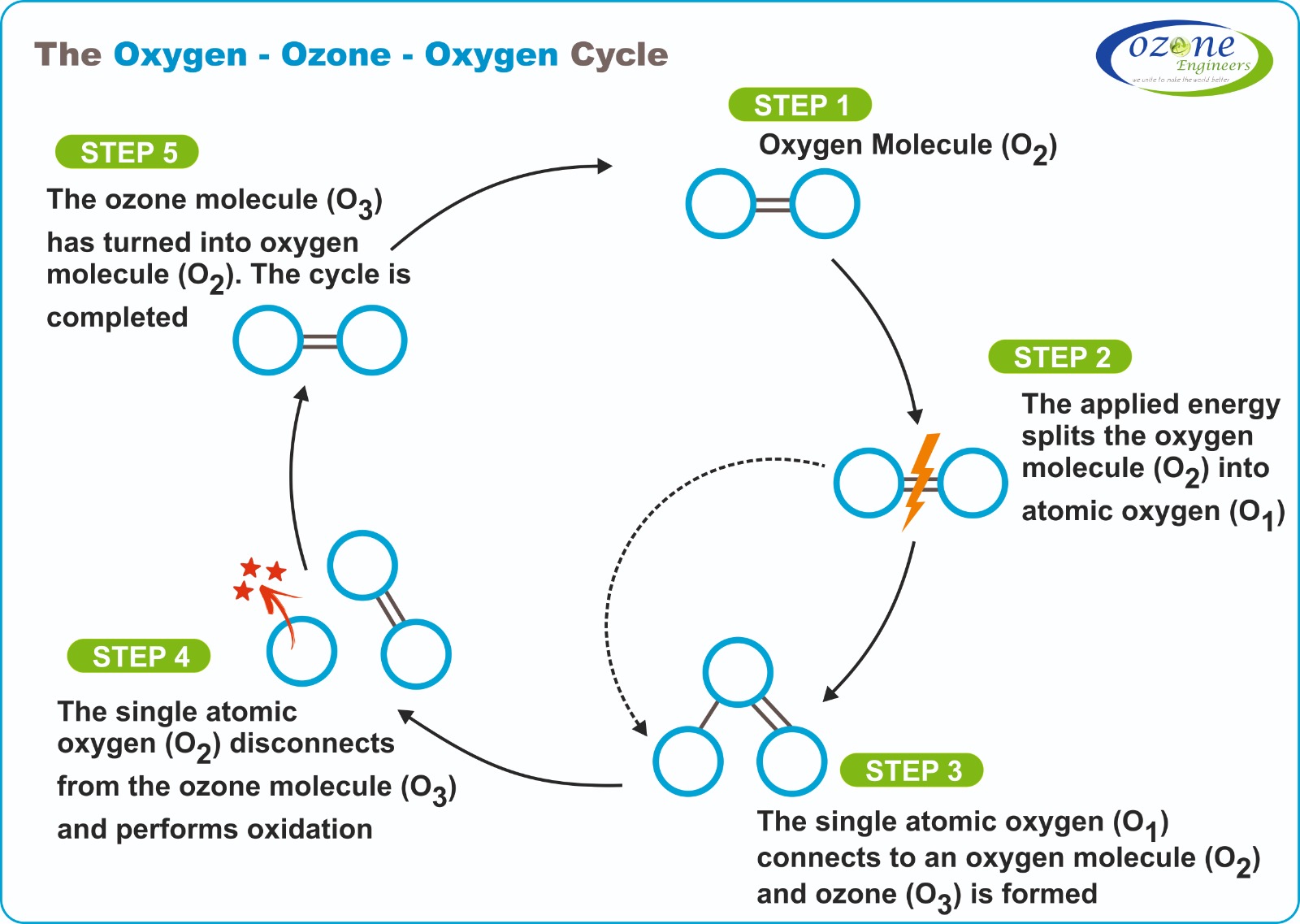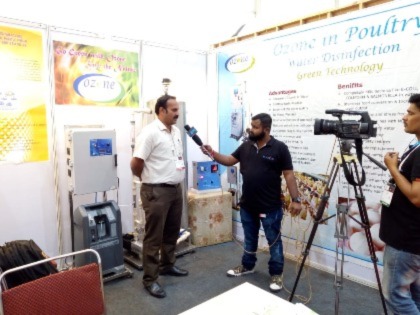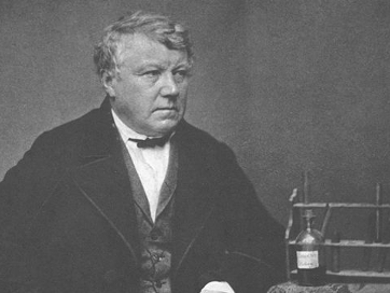
Ozone (O3) is a form of oxygen that has one more oxygen atom than the atmospheric oxygen (O2) we breathe. It’s this third oxygen atom that makes the ozone molecule so unstable, which is the key to its oxidizing power. Since ozone is unstable, it has a fairly short half-life under normal conditions, so it has to be produced and supplied continuously to a disinfection process.
This is where OZONE ENGINEERS comes in: OUR systems manufacture and deliver ozone in exactly the right quantities to provide the needed disinfection power for a given application.
The chemical reaction that results in ozone is pretty simple. Ozone is a form of oxygen that is created when electrical energy breaks apart an ordinary oxygen molecule (O2) starting a chemical reaction that results in ozone (O3).
Ozone (O3) is a form of oxygen that has one more oxygen atom than the atmospheric oxygen (O2) we breathe. It’s this third oxygen atom that makes the ozone molecule so unstable, which is the key to its oxidizing power. Since ozone is unstable, it has a fairly short half-life under normal conditions, so it has to be produced and supplied continuously to a disinfection process.
This is where OZONE ENGINEERS comes in: OUR systems manufacture and deliver ozone in exactly the right quantities to provide the needed disinfection power for a given application.
The chemical reaction that results in ozone is pretty simple. Ozone is a form of oxygen that is created when electrical energy breaks apart an ordinary oxygen molecule (O2) starting a chemical reaction that results in ozone (O3).

The unstable third oxygen atom can combine with organic and inorganic molecules to destroy or change them through oxidation. This process happens almost instantaneously. For example, ozone in a swimming pool will kill Cryptosporidium parvum practically on contact, whereas chlorine in normal pool concentrations would take hours to kill it. Like chlorine, ozone is “used up” in the oxidation process, and has to be re-supplied.
Ozone oxidizes a very large range of other substances. In a pool, these organic molecules can be viruses, bacteria, fungi, yeast, oils, organic chloramines, etc., and inorganic molecules can be dissolved metals such as iron, copper and manganese, and inorganic forms of chloramine. On a food preparation surface, or on the food itself, the target organism might beSalmonella, Listeria, E. coli or any number of other dangerous microorganisms. In hospital or long-term care laundry, the ozone kills the dangerous antibiotic resistant staph bacteria (MRSA) that can be carried on clothing or bedding.
The chemical process of ozone oxidation is relentless. It continues until the ozone is completely destroyed (actually, it is “reduced” in the process of “oxidizing” other substances). When this beneficial third unstable atom completes its oxidizing duties, it leaves behind only the familiar oxygen molecule like the ones in the air we breathe, O2.
Ozone oxidizes a very large range of other substances. In a pool, these organic molecules can be viruses, bacteria, fungi, yeast, oils, organic chloramines, etc., and inorganic molecules can be dissolved metals such as iron, copper and manganese, and inorganic forms of chloramine. On a food preparation surface, or on the food itself, the target organism might beSalmonella, Listeria, E. coli or any number of other dangerous microorganisms. In hospital or long-term care laundry, the ozone kills the dangerous antibiotic resistant staph bacteria (MRSA) that can be carried on clothing or bedding.
The chemical process of ozone oxidation is relentless. It continues until the ozone is completely destroyed (actually, it is “reduced” in the process of “oxidizing” other substances). When this beneficial third unstable atom completes its oxidizing duties, it leaves behind only the familiar oxygen molecule like the ones in the air we breathe, O2.
The potent disinfecting power of ozone can benefit the environment in many important ways. Ozone can replace chlorine, hot water, and steam in many applications thereby reducing the consumption of chemicals and water, as well as eliminating the energy required to produce hot water and steam.
Ozone is one of nature’s most powerful disinfectant oxidizers. On a base average (depending on the microorganism or organic contaminant), it is 200 times stronger than chlorine.
Ozone oxidation means destroying substances chlorine can’t effectively eliminate, like human fluids, cosmetics, and organics of all kinds, as well as dissolved metallic substances like iron and manganese.
The breadth of ozone effectiveness means protection against emerging threats like endocrine disruptors (byproducts of pharmaceutical disposal) in the water supply.
Ozone interrupts the chemical process that creates hazardous byproducts of chlorine sanitation such as chloramines. It acts on both the organics that are part of the chloramine formation process and on the chloramines themselves.
When properly applied with a ozone system, ozone oxidation creates no byproducts or residues that require cycle after cycle of cleaning and rinsing – the only thing left behind is ordinary oxygen.
Ozone is highly effective in cold water, which saves a lot of energy and also enables applications, such as surface disinfection, where heating hot water in sufficient quantities is simply not feasible or too expensive
Ozone is tested and proven effective against tough microorganisms like crypto (Cryptosporidium parvum) and MRSA (antibiotic resistant staph). Ozone is effective against a very wide array of threatening microorganisms such as E.coli and Salmonella, Listeria, Pseudomonas and so forth.
Ozone is recognized as an antimicrobial disinfectant by the EPA and by the FDA for direct food applications as well as food processing surface disinfection.
Ozone applications are recognized as safe and effective when applied in compliance with NSF/ANSI Standard 50, OSHA and UL lab standards.


OZONE IS NATURE’S POWERFUL SANITIZER
Ozone has existed in nature since lightning first arced through an oxygenated atmosphere, and has always been easily identified by its unique smell, even in small concentrations. But only since the advent of scientific research and technology has it been identified and understood properly.
OZONE IDENTIFIED AS A DISTINCT SUBSTANCE
Ozone was first identified as a distinct chemical substance by the German scientist Christian Friedrich Schönbein in 1840. In his experiments with electrolysis and electrical sparking, he recognized a scent as the same odor found after a lightening flash. He named the substance “ozone” from the Greek term for “smell”. However, Schönbein did not know what the nature of the substance was. From his own research, he noted that the ozone scent was detected as soon as the electrolysis of water started. He executed a number of experiments using a variety of electrolytes with chemicals in solution, and exposed the ozone to other chemicals after it was produced. He found a number of results that we now understand much better, although at the time he did not find the correct explanations. For example, he noted that the ozone smell was not created when using chemical solutions of ‘halides’. Remarkably, from these kinds of very elementary findings, he suggested that the substance’s odor “must be due to some gaseous substance disengaged (conjointly with oxygen) from the fluid due to the decomposing power of the current.” *
THE SYNTHESIS OF OZONE
The chemical identity of ozone (O3) was finally identified by Soret in 1865, and the result was confirmed shortly before Schönbein’s death in 1867. Technology has progressed a long way since then, though the basic techniques are the same.
At its most basic, industrial ozone is created by flowing oxygen between a charged anode and cathode pair. The electrical field breaks the oxygen molecule (O2) into two oxygen atoms (O) which instantly form a weak bond with an ordinary oxygen molecule to make ozone (O3). This method is similar to the action of lightning surging through the atmosphere.